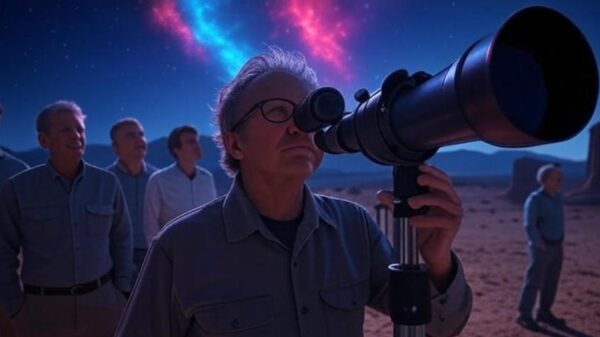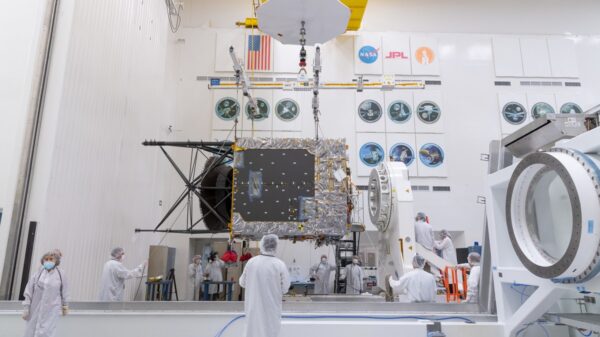Imagine a water world dominated by creatures resembling octopuses. Envision a planet divided between light and darkness, where the sun never emerges. Picture a fiery inferno where molten rocks cascade from the heavens.
These descriptions are not from science fiction novels, but rather of exoplanets that are currently considered the most likely to support alien life. Numerous exoplanets, orbiting stars beyond our solar system, have been identified as “potentially habitable” or “terrestrial” and are extensively detailed in a new book.
In “Alien Earths,” Dr. Lisa Kaltenegger, an ex-NASA mission judge, suggests that the astronomical discoveries of the last three decades herald a new golden age of exploration.
Since the discovery of the first exoplanet in 1992, over 5,000 have been confirmed in our galaxy, with 70 possessing the ideal conditions for life.
Considering some are 17,000 light-years away, a distance that would take NASA’s Juno spacecraft 6.9 million years to traverse, Dr. Kaltenegger believes the next great challenge for humanity is to find creative ways to detect and communicate with extraterrestrial life.
“I hope to convey how difficult the search for extraterrestrial life will be. We may not even recognize her when she looks us in the eye,” says Dr. Kaltenegger in her book.

Since the initial recording in 1992, over 5,000 planets have been discovered outside our solar system. The first of these “exoplanets,” a Jupiter-like gas giant, is known as “Dimidium.”
“Solving the puzzle of these new worlds requires the use of a wide range of tools, such as growing colorful habitats in our biology lab […] and looking back at Earth’s long history of evolution for clues about what to look for,” the former NASA scientist explained.
Dr. Kaltenegger, the founding director of the Carl Sagan Institute at Cornell University and a professor, stated that Earth should serve as “our laboratory” for testing new concepts regarding the diverse evolution of life throughout the galaxy.
“The signs of extraterrestrial life are written in the light of a planet”
Currently, the University of Puerto Rico’s Planetary Habitability Laboratory indicates that 29 identified rocky exoplanets are most likely to support life, at least as we understand it on Earth.
Additionally, astronomers consider another 41 exoplanets as “water worlds”—akin to smaller versions of Neptune in our solar system—which also makes them potential candidates for hosting extraterrestrial life, albeit to a lesser extent.
The $10 billion James Webb Space Telescope (JWST), launched in 2021, gathers light from deep space with a mirror over six times larger than that of the renowned Hubble Telescope, which has significantly contributed to the discovery of these new exoplanets.
“James Webb is the first telescope capable of capturing just enough light with the 6.5-meter mirror to explore the chemical composition of the atmospheres of other rocky worlds,” Dr Kaltenegger told Big Think.
“Size is the key to collecting light. Imagine a bucket: the larger it is, the more rainwater it can collect […] The telescope’s mirror works the same way: the larger it is, the more light it can collect,” she explained.
Dr. Kaltenegger suggests that the indicators of extraterrestrial life on other planets are “inscribed in the planet’s light—if one knows how to interpret it.”
When the light from distant stars traverses or bounces off an exoplanet’s atmosphere, “the alien world’s atmospheric chemical composition is imprinted in the light that arrives at my telescope,” she explains.

Three planets that could harbor unexplored extraterrestrial life
The most distant planets, like the lava world CoRoT-7 b located 489 light-years from Earth, would be too inhospitable with their perpetual magma heat to support life.
However, only three distant star systems with exoplanets have shown hints in their light spectra that suggest the possibility of unexplored extraterrestrial life.
Kepler-62: A star system with global oceans
“Life that never left the oceans could be fascinatingly stranger than we could ever imagine,” Dr. Kaltenegger writes in her book.
The orange dwarf star Kepler-62, situated approximately 980 light-years from our solar system, boasts at least two potential water worlds in its orbit: Kepler-62e and Kepler-62f.
These exoplanets are sized between Earth and Neptune. Notably, Kepler-62f is considered one of the “most promising planets discovered” for the potential support of extraterrestrial life, as per a 2015 NASA research paper.
But what can live there?
“The octopus-like creatures, the heptapods, envisioned in Ted Chiang’s 1998 science fiction novel Story of Your Life, which forms the basis of the 2016 film ‘Arrival,’ cross my mind when I think of large ocean worlds,” said Dr. Kaltenegger.
In the 2016 science fiction drama directed by Denis Villeneuve, who also directed Dune, towering tentacled aliens impart a language to a human linguist, portrayed by Amy Adams, that alters her very perception of space and time.
Advanced beings residing in the water worlds of Kepler-62 might exhibit turbulent behavior and mental instability, as suggested by Dr. Kaltenegger. However, she expresses doubt about their capacity for space travel, unlike the entities in Chaing’s narrative.
“Life on these worlds would be under water without easy access to metals, electricity or fire for metallurgy,” she said shortly after NASA’s Kepler space telescope first discovered the worlds.
“Nevertheless, these worlds will still be beautiful blue planets orbiting an orange star,” the astrophysicist added, “and perhaps the ingenuity of life to reach a technological stage will surprise us.”
Despite the absence of advanced extraterrestrial life, Dr. Kaltenegger remains optimistic that the planets of Kepler-62 could eventually become prime destinations for human tourists.
“These worlds could be some of the best surfing spots in the universe,” she said.

TRAPPIST-1: Sunset worlds with glowing algae
Merely 40 light-years from Earth, a closely-bound group of exoplanets circles the red dwarf star TRAPPIST-1, with three of these worlds residing in its “habitable zone.” These planets may have the potential to sustain life, as suggested by Dr. Kaltenegger.
“How much farther away would our space travel capability be if there were another habitable world orbiting our Sun,” she wonders in her book.
Among the seven exoplanets nearest to TRAPPIST-1, designated TRAPPIST-1b through TRAPPIST-1h, two particularly stand out to astronomers for their moderate temperatures and other suitable characteristics: TRAPPIST-1e and TRAPPIST-1f.
TRAPPIST-1e, with a mass merely 70% that of Earth’s, orbits its star at a mere 2.7 million miles away—a tiny fraction of the 93.6 million miles separating Earth from the sun.
TRAPPIST-1f, only 4% larger than Earth, circles its star at a slightly greater distance, just 3.6 million miles.
These extraterrestrial planets are so proximate to TRAPPIST-1—a “supercool dwarf star” with a luminosity 2,000 times dimmer than the sun—that their orbital period around the star is just a matter of days.
A “year” on TRAPPIST-1e lasts scarcely 6.1 days, barely longer than on TRAPPIST-1f, which takes 9.2 days to complete its orbit.

“This planetary system is so densely stacked that TRAPPIST-1d and TRAPPIST-1f would both appear as large as our moon in the night sky of the middle planet TRAPPIST-1e,” Dr. Kaltenegger said, likely becoming cultural points of contact for any alien civilizations millennia before coming to meet their closest alien neighbors.
Some scientists posit that if extraterrestrial beings on TRAPPIST-1e possessed telescopes as advanced as NASA’s James Webb Telescope, they might be able to observe our planet from afar.
Astrobiologist Jacob Lustig-Yaeger from Johns Hopkins University, along with his team, input atmospheric data from Earth into a simulation of the distant, aquatic exoplanet. They concluded that an alien equivalent of the JWST could likely detect signs of human life.
From their vantage point 40 light-years away, such a telescope, if deployed by extraterrestrials on TRAPPIST-1e, could identify distinct molecular signatures in our atmosphere indicative of technological civilization, namely pollutants.
“Chlorofluorocarbons (CFCs) have been proposed as technosignatures because of their many industrial applications and their notoriety as catalysts of O3 depletion,” Lustig-Yeager and his team wrote in their paper.
Proxima Centauri: The sun never sets
One of our solar system’s closest neighbors, the Proxima Centauri star system is just 4.25 light-years away, about one-tenth the distance of star systems like TRAPPIST-1.
Proxima Centauri b, deemed “most likely habitable,” is tidally locked with its host star, which, according to Dr. Kaltenegger, means it is a planet “where the sun never sets or rises.”
Life, she speculates, could thrive in the perpetual twilight of the terminator line, the boundary separating the planet’s day and night sides, basking in just enough stellar energy to sustain itself.
“Red puffy clouds fill an orange sky, high above the purple moss that dots the few exposed islands on the horizon,” she writes in her book Alien Earths. “The waves break on the small pieces of shore, shimmering in the red sunlight above.” “Pushing a lens across the border to the dark side of Proxima Centauri b could potentially lead to the discovery of many species that evolved to produce light themselves,” continues Dr. Kaltenegger.

In 2016, Dr. Kaltenegger and her colleague at Cornell, Dr. Jack O’Malley-James, explored an additional possibility for the sustenance of life on Proxima Centauri b: a biological shield that might safeguard its inhabitants from the frequent and intense solar storms of their star.
“For the duration of a flare, the planet should glow, and this change could be strong enough to be detected on planets around nearby stars by flare,” said Dr. O’Malley-James for their research, which was published in the Monthly Notices of the Royal Astronomical Society.
The theory is merely one instance of Dr. Kaltenegger and her team applying the concept of utilizing Earth’s most unusual life forms to conceptualize the variety of extraterrestrial life that exists light years distant.


















